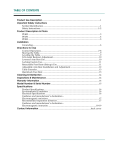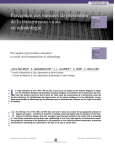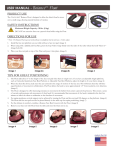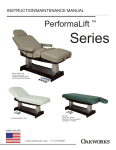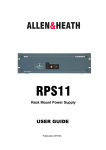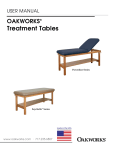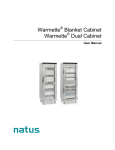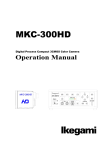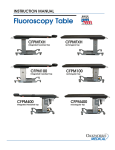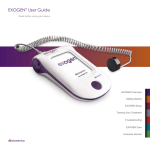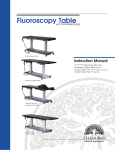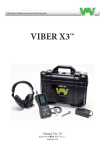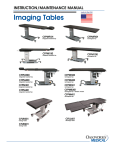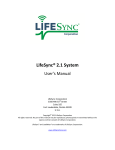Download 300 Series Procedure Chair Manual
Transcript
Table of Contents Product Use Description ..................................................................................................... 1 Important Safety Instructions Symbol Identification..................................................................................................... 1 Safety Instructions ......................................................................................................1-2 Product Description & Photo 300 Series Procedure Chair ........................................................................................... 3 Installation Grounding ...................................................................................................................... 4 Directions for Use Hand Control Operations............................................................................................. 5 Foot Control Operations............................................................................................... 6 Swivel Base Use............................................................................................................. 7 Retractable Foot Rest (stirrup) Use.............................................................................. 7 Head Rest Use................................................................................................................ 8 Procedure Tray Use....................................................................................................... 9 Fixed T-Rail ................................................................................................................... 9 Arm Rest Installation and Adjustment....................................................................... 10 Paper Roll Holder Use................................................................................................ 10 Procedure Chair Face Rest Crescent.......................................................................... 11 T-Rail Adapter............................................................................................................. 11 Power Outlet Use........................................................................................................ 11 Cleaning & Disinfection .................................................................................................... 12 Inspections & Maintenance ............................................................................................. 12 Warranty Information ......................................................................................................... 12 Model Number & Serial Number ..................................................................................... 13 Specifications Product Specifications ................................................................................................ 14 Environmental Conditions ........................................................................................ 14 Electrical Specifications ............................................................................................. 14 Guidance and manufacturer’s declaration Electromagnetic emissions ........................................................................................ 15 Recommended separation distances ......................................................................... 15 Guidance and manufacturer’s declaration Electromagnetic immunity ................................................................................... 16-17 Revision History.................................................................................................................... 20 Contact Information.............................................................................................back cover Product use description / important safety instructions product use description The Procedure Chair is a powered positioning examination table used to support the patient during medical procedures. It is intended to be operated by a healthcare professional in a medical environment. No special training is required but a review of the following Safety Instructions is important for the safety of the operator and patient. The healthcare professional should read and understand this entire manual before use with a patient. There are no known contradictions to the use of this equipment. Symbol Identification This symbol, when used in this manual and on product labels, represents a caution warning. Be sure to read and comply with all precautions and warnings. This symbol, when used in this manual and on product labels, warns against an electrical shock hazard. Be sure to observe and comply with all warnings. This symbol, when used in this manual or on product labels, indicates a Protective Earth (Ground) Terminal. This symbol, when used in this manual or on product labels, indicates that the product should be protected from moisture. The humidity specifications for Transport & Storage are listed in the environmental conditions section of this manual. This symbol is used to indicate that the operator should consult the user manual. ~ ---- This symbol, when used in this manual and on product labels, indicates that the table and components are a Type B Applied Part pursuant to IEC 60601-1: 2005. This symbol, when used in this manual or on product labels, indicates alternating current (AC). This symbol, when used in this manual or on product labels, indicates direct current (DC). important safety instructions caution Read and Save These Instructions The Back Rest and Leg Rest sections are not designed to support the entire weight of the patient. Do not sit on the Back Rest or Leg rest sections. Medical Electrical Equipment needs special precautions regarding EMC and needs to be installed and put into service according to the EMC information provided in this manual. Portable and mobile RF communications equipment can affect Medical Electrical Equipment. The use of accessories, transducers, and cables other than those specified by the manufacturer, may result in increased emissions or decreased immunity of the Procedure Chair. 1 Important Safety instructions The arm rests are not designed to be used as patient restraints. Use appropriate patient restraints. The chair should not be used adjacent to or stacked with other equipment and that if adjacent or stacked use is necessary, the chair should be observed to verify normal operation in the configuration in which it will be used. The chair is designed to be a stand alone chair. This chair must not be modified or incorporated into any other equipment. As with any moving mechanism there are potential pinch points around and underneath the chair. It is the responsibility of the operator of this equipment to insure that bystanders are not in the area below or around this equipment during operation. Proper operation of this equipment is very important for the safety of the operator, patient, and any other individuals in the area of this equipment. Directions for use of this equipment are described in this manual. The operator should read these sections carefully. Weight Limit: (patient and accessories) 550 lbs./250 kg. Do not exceed. Be certain that the chair is completely lowered without any tilt being present prior to discharging an ambulatory patient. The patient may lose balance and fall. This chair is not suitable for use in the presence of flammable anesthetic mixture with air or oxygen or nitrous oxide. When lowering the chair or using the Trendelenburg functions, make sure there is nothing underneath the chair that can impede motion (like stools, cabinets, accessory parts, cleaners, etc.). Use this furnishing only for its intended use as described in these instructions. Do not use attachments not recommended by the manufacturer. Close supervision is necessary when this furnishing is used near children or disabled persons. The Oakworks Procedure Chair has two lifting columns that raise and lower the chair and three actuators that allow the client to be positioned for both client and therapist comfort. Each of these devices has a duty cycle of approximately 10%, meaning 2 minutes of operation within a 20 minute period. Exceeding this duty cycle can damage the equipment. Do not sit on the Backrest or Leg Rest. WARNING To reduce the risk of burns, fire, electric shock or injury to persons: 1. Unplug this furnishing from the electrical outlet before cleaning. 2. Unplug from outlet before adding or removing parts. 3. Never operate this furnishing if it has a damaged cord or plug, if it is not working properly, if it has been dropped or damaged, or dropped into water. Contact Oakworks Customer Service before use. 4. Keep the cord away from heated surfaces. 5. Never drop or insert any object into any opening. 6. Do not use outdoors. 7. Do not operate where aerosol (spray) products are being used or where oxygen is being administered. 8. The maximum amperage for the Power Outlet is 3 amps. Connecting equipment that exceeds this rating will damage the system. Only connect low current devices. Do not connect an extension cord or power strip to the Power Outlet. Do not touch equipment connected to the Power Outlet and the patient at the same time. Any electrical accessories used with this table must comply with approved medical standards. Equipment relying only on Basic Insulation (only one means of electrical protection for the patient / pratitioner) must not be used. danger Risk of electric shock - Connect this furnishing to a properly grounded outlet only. See Grounding Instructions in this manual. Electrical Shock Hazard. The power supply/control module is located under the chair seat. No user serviceable parts are inside the control box. Refer servicing to qualified personnel. Unplug wall plug prior to contact with any cables connected to the power supply. 2 Product Description 300 Series Procedure Chair Adjustable Head Rest (accessory) 12 Button Hand Control Paper Roll Holder (1) Self-Adjusting Removable Arm Rests (2) (accessory) Retractable Foot Rests (Stirrups) (2) (option) Fixed T-Rail (2) (option) Rotate up to 240 º electric adjustment 0° to 80° Electric Back Rest electric adjustment 0° to 90° Swivel Base (option) Electric Leg Rest Electric Lift Towers (2) Standard Specifications Motion 1 Powered 19”-35” (48-89 cm.) Height Range Motion 3 Powered 0-80º Back Rest Motion 2 Powered +15º/-5º Trendelenburg/ Reverse Trendelenburg Motion 4 Powered 0-90º Leg Rest Hand Control All motions and memory function Paper Roll Holder Accommodates up to 18” (46 cm.) rolls (roll not included) 3 Section Top 74” (188cm) long (80” (203cm) long with Head Rest extended) x 27” (69cm) wide Table Voltage Options 120V/60Hz or 230V/50Hz Back Rest Section 26” long x 27” wide (66 x 69cm) Table Capacity 550 lbs. (250 kg.) (patient and accessories) Seat Section 22.5” long x 27” wide (57 x 69cm) Padding 3” (8 cm.) Comfort Foam™ Leg Rest Section 13” long x 23” wide (33 x 58cm) Upholstery Terra Touch™ Warranty 3 year parts, 1 year labor Enclosure Thermoformed Plastic Safety Listings FDA, cETLus, CE marked Table Weight* 359 lbs. (163 kg.) Options Accessories Retractable Foot Rests (Stirrups) Pull out from under seat section, fully adjustable Foot Control Fixed T-Rail Procedure Tray 11” long x 10” wide (28 x 25cm), adjusting angle & height, removable Supports all powered motions Adjustable Head Rest OR Large Head Rest available on one or both sides of the seat T-Rail Adapter Attaches to the backrest on one or both sides 12.25” x 10.25” (31 x 26cm), 2 qt./1.9 l. Procedure Chair Face Rest Crescent For prone use (adjustable head rest required) Swivel Base 240º of rotation (adds 1.5” (4cm) to height range & 60 lbs. (27 kg.) to the weight) Padding 4” (10 cm.) Comfort Foam™ Arm rests (2) 11.5” long x 20” wide (29cm x 51cm), removable Auto level design adjusts to backrest angle, swing out 90°, 24” Lg x 5” W (61 x 13cm), removable For electrical specs, see Specifications section. 3 installation The Procedure Chairs come completely assembled and ready to use. Plug the cord into a functioning outlet that is rated for the table. (see Grounding below) Arrange the power cord and control cords so that they will not create a tripping hazard and where the controls are located to your liking and are conveniently accessible. Be sure access to plug is not blocked for disconnecting the table from power. Grounding DANGER Risk of Electric Shock - Connect this furnishing to a properly grounded outlet only. This product must be grounded. If it should malfunction or break down, grounding provides a path of least resistance for electrical current to reduce the risk of electric shock. This product is equipped with a cord having an equipment-grounding conductor and a grounding pin. The pin must be plugged into an appropriate outlet that is properly installed and grounded in accordance with all local codes and ordinances. See U.S. sample below. Grounding Methods Correct Implementation Incorrect Implementation Improper connection of the equipment-grounding conductor can result in a risk of electric shock. Check with a qualifie d electrician or service person if you are in doubt as to whether the product is properly grounded. Do not modify the plug provided with the product - if it will not fit the outlet; have a proper outlet installed by a qualified electrician. 4 directions for use hand control operations caution Do not sit on the Fowler (Backrest) or Leg Rest sections. Do not leave the patient unattended. When lowering the chair or using the Trendelenburg functions, make sure there is nothing that can impede motion (like stools, cabinets, accessory parts, cleaners, etc.) The Multi-function Hand Control operates all functions by holding down one button at a time. Follow the directions below to access these functions. If a function button does not release, pressing and holding any other function button will stop the motion. Trendelenburg - head end down (up to 15º) Height Up Reverse Trendelenburg foot end down (up to 5º) Height Down Back Rest Up Back Rest Down Leg Rest Up Leg Rest Down Fully down and seated position Zero-Gravity Memory Function Use Fully up and flat position Memory Function Use any of the top 8 buttons to orient the chair in a favorite position. Press and release the MEM button twice within five seconds and listen for two quick beeps. Your position is now set when you use this button. To set the chair into a different position, simply follow steps above to readjust your memory position. 5 directions for use foot control operations caution Do not sit on the Fowler (Backrest) or Leg Rest sections. Do not leave the patient unattended. When lowering the chair or using the Trendelenburg functions, make sure there is nothing that can impede motion (like stools, cabinets, accessory parts, cleaners, etc.) The Multi-function Foot Control operates all functions by holding down one button at a time. Follow the directions below to access these functions. If a function button does not release, pressing and holding any other function button will stop the motion. The foot control has no memory positions. Height Up Back Rest Up Trendelenburg - head end down (up to 15º) Leg Rest Up Reverse Trendelenburg foot end down (up to 5º) Leg Rest Down Height Down Back Rest Down 6 directions for use sWIVEL bASE uSE caution When rotating the chair, make sure there is nothing around the chair that can impede the rotational motion (like stools, cabinets, etc) Rotate up to 240 º The chair can be rotated with a patient in it. Locate the black push buttons at the top of the back rest section. Press in and hold either one of the buttons to disengage the base locking mechanism. While holding in the push button, rotate the chair to the desired position up to 240°. retractable foot rests (stirrup) use caution 1. Fully lower the powered foot rest to allow access to the stirrup. Pinch Point - Keep fingers away from pinch point. 2. Grasp Stirrup handle & pull out firmly while lifting slightly. Pull fully out. 3. Fold out to fully open position. To store stirrups, lift slightly, rotate towards the middle of the chair and fold the foot rest down. Then lift slightly and push into the storage position. 4. To rotate stirrup to the desired angle, lift slightly and move to the desired position. There are 3 detent positions. Stop lifting and move slightly left or right for the nearest detent position. 5. To reduce stirrup length, lift the handle slightly and push into desired position. Stirrup will automatically lock into nearest detent position. 7 directions for use Head Rest uSE caution Do not extend the dowels more than 4” (10 cm.) from the Back Rest section. Adjustable Large The Adjustable head rest angle is adjusted using a locking knob. The head rest distance from the table is adjusted by using a knob. The Large head rest is adjusted by using the knob. To adjust the position of the head rest, follow these steps: hEAD rEST aNGLE (Adjustable Head Rest only) Turn knob counter-clockwise to unlock the cam. Move head rest platform to the desired position. Turn knob clockwise to lock the cam. hEAD rEST aNGLE (Adjustable Head Rest only) Loosen knob by turning counter-clockwise. Pull up on the head rest to expose the dowels. Firmly tighten the knob by turning clockwise to avoid slipping when in use. 8 directions for use procedure tray use caution Make sure the Leg Rest is fully lowered before using the procedure tray. Do not sit or push on the Procedure Tray when extended from the seat. Maximum Weight rating of 15 lbs. (6.8 kg.) Do not use the Procedure Tray when using the Trendelenburg function. The Chair seat must remain flat while using the Procedure Tray. Slide out the Procedure Tray by pulling on the center slot of the tray holder until the tray stops. After a procedure is performed, remove the Procedure Tray with both hands at the side notches from the tray holder. Discard fluids, clean and place back into tray holder. cleaning and disinfecting instructions If fluid spill under the seat cushion, follow these instructions: 1. Remove the seat pad by pulling up from the edge. The pad is held on by Velcro. 2. Pull out the 2 pins on both sides of the metal plate near the end of the Procedure tray holder. Slide the tray holder and Procedure Tray out from the seat section. 3. Unscrew the 4 black handles at the corners of the metal plate. Slide the metal plate off from the seat section and disinfect all surfaces. fixed t-rail The Fixed T-Rail can be on one or both sides of the seat section, allowing the use of any t-rail accessory with a Maximum Load Capacity of 150 lbs. (68 kg.) Clamp & pole not included. 9 directions for use Arm Rest Installation and Adjustment caution Do not use the arm rest for patient support during the mounting or dismounting of the chair. The arm rest is not designed to support the patient’s weight. to install the arm rests: The Arm Rests adjust automatically as the back rest moves to remain parallel to the floor. 1. Insert end of arm rest into backrest hole while holding the arm rest at a 60° angle to the backrest. 2. Push end all the way into the hole and drop the arm rest into the horizontal position. Pull outward to make sure the arm rest is secure. To remove the arm rest, simply reverse the procedure above. If the Arm Rest(s) are not level – Refer to the Service Manual. paper roll holder use To load the paper, locate the two paper holder support arms located on the underside of back rest. Insert rod through paper roll and place rod into the holes in the support arms. Pull paper and thread through the straps across the upholstered top to keep in place. Note: The paper “hold down” strap is attached with Velcro®. This allows strap tension adjustment if necessary. 10 directions for use Procedure Chair Face Rest Crescent The Procedure Chair Face Rest Crescent is designed to be used for prone positioning. An Adjustable Head Rest is required for this accessory. T-Rail Adapter The T-Rail Adapter can be attached at designated locations on one or both sides of the back rest section, allowing the use of any t-rail accessory. Attach or remove using knobs. The T-Rail Adapter has a Maximum Load Capacity of 150 lbs. (68 kg.) power outlet use The maximum amperage for the Power Outlet is 3 amps. Connecting equipment that exceeds this rating will damage the system. Only connect low current devices. Do not connect an extension cord or power strip to the Power Outlet. Do not touch equipment connected to the Power Outlet and the patient at the same time. Any electrical accessories used with this table must comply with approved medical standards. Equipment relying only on Basic Insulation (only one means of electrical protection for the patient / pratitioner) must not be used. warning The Power Outlet can be used to connect low power devices such as localized illumination, computers, micro-controllers, etc. Exceeding the maximum current will interrupt the power. 11 cleaning & disinfection / inspections / warranty cleaning & disinfection warning Before cleaning with any liquid cleaner be sure to unplug the power cord from the outlet. Use a 10% sodium hypochlorite (bleach) solution or Recommended Disinfectants on all surfaces. Clean all sides of each upholstered section. Follow the directions on the disinfectant and wipe off excess. Recommended Disinfectants Protex, MadaCide, Accell TB, Virox® Note: Damage caused by unapproved substances will not be covered under the warranty. DO NOT use citrus based cleaners or other strong cleaners, such as alcohol, acetone, higher concentrations of bleach or other products that contain high concentrations of these substances. DO NOT expose the fabric to temperatures below 50°F/10°C or above 104°F/40°C. DO NOT expose the fabric to direct sunlight, adhesives, liquids, or abrasive materials. inspections & maintenance RECOMMENDED REGULAR INSPECTIONS (monthly or local standard) • Check for damage to the power, hand control or foot control cables. • Visually inspect components for obvious damage that could cause problems during operation. RECOMMENDED PERIODIC INSPECTIONS (yearly or local standard) • Check for damage to the power, hands control or foot control cables and all visible wiring. • Visually inspect components for obvious damage that could cause problems during operation. • Check all mechanical functions using the hand control. Repeat using the foot control. Check for abnormal noises. • Replace any missing or illegible labels. • Check that all fasteners are present and fastened securely. • Check table grounding. • Clean unusual buildup of dirt on the chair and/or parts of the chair not normally cleaned on a regular basis. • Check for tears or cracks in the upholstery. MAINTENANCE • No specific maintenance tasks are required. • Oakworks medical tables/chairs are designed and built to provide many years of dependable service. Please follow local regulations and laws when disposing of the electrical components used in this chair. • For all Customer Service related problems refer to the Service Manual warranty View complete warranty details at www.oakworks.com 12 model number & serial number model & serial numbers The model number and serial number are located on the seat acrylic on the backside of the chair. Procedure Tables and Chairs Model Number 3034177 16796025 PC30G32719743MTTZZH8BK Ser#: PC1565022 PCM 300 Series 27 x 19-35 x 74 3M/TT/XXH8BK TTSKYBLUE 01/04/2013 Order#:654321 Notes: Sample Product Label Serial Number Power Rating: US 120 V 60 Hz 5.8 A Duty Cycle: MAX 2 minutes ON/18 minutes OFF Class 1 Equipment 923 East Wellspring Rd., New Freedom, PA 17349 USA Phone: 717-235-6807 www.oakworks.com CONFORMS TO: ANSI/AAMI STD ES60601-1 IEC STD 60601-1-6 Certified to CAN/CSA STD C22.2 No. 60601-1 European Authorized Representative: Emergo Europe Molenstraat 15 The Hague, 2513 BH Netherlands Part No. 70537-7 rev. C Model Numbers and Serial Numbers always start with a letter. Model Number description PC30 g3Xxxxxx3MTT xxxx Options Spaces not used Fabric: TerraTouch Padding: A3 = 3” (8 cm.) Comfort Foam A4 = 4” (10 cm.) Comfort Foam Table Top Length Minimum Table Height Table Width Top - 3 section Back Rest Base: 30 = Standard Base SW = Swivel Base Procedure Chair 13 specifications product specifications Weight 280-325 lbs. (127-148 kg.) Shipping Weight 372-417 lbs. (169-189 kg.) Lifting Capacity 550 lbs. (250 kg.) environmental conditions Conditions Normal Use Storage & Transport Temperature Humidity 50° (10°C) to 104° (40°C) 20% to 60% RH 98 to 105 kPa Atmospheric Pressure -20° (-29°C) to 135° (57°C) 20% to 95% RH 98 to 105 kPa electrical specifications Designed for: North America Europe Input Service 120 VAC/15 amp/60 Hz 230 VAC/10 amp/50/60 Hz Current Draw 5.8 amps 2.9 amps Maximum Momentary Current Consumption 6.0 amps 3.0 amps 24 VDC 24 VDC Class 1 Equipment Class 1 Equipment Voltage Output to Actuators Electric Shock Protection Tabletop Applied Part Ingress Protection Rating Type B Applied Part Type B Applied Part IPX0 IPX0 Made of Operation Intermittent Operation MAX 2 minutes ON 18 minutes off Intermittent Operation MAX 2 minutes ON 18 minutes off Fuse Specifications M 10AL 125V M 10AL 125V 14 specifications Guidance and manufacturer’s declaration - electromagnetic emissions The chair is intended for use in the electromagnetic environment specified below. The customer or the user of the chair should assure that it is used in such an environment. Emissions Test Compliance RF emissions CISPR 11 Group 1 RF emissions CISPR 11 Class A Harmonic emissions IEC 61000-3-2 Class A Voltage fluctuations / flicker emissions IEC 61000-3-3 Complies Electromagnetic environment - guidance The chair uses RF energy only for its internal function. Therefore, its RF emissions are very low and are not likely to cause any interference in nearby electronic equipment. The chair is suitable for use in all establishments other than domestic and those directly connected to the public low-voltage power supply network that supplies buildings used for domestic purposes. Recommended separation distances between portable and mobile RF communications equipment and the chair The chair is intended for use in the electromagnetic environment in which radiated RF disturbances are controlled. the customer or the user of the table can help prevent electromagnetic interference by maintaining a minimum distance between portable and mobile RF communications equipment (transmitters) and the chair as recommended below, according to the maximum output of the communications equipment. Separation distance according to frequency of transmitter (m) Rated maximum output power of transmitter 150 kHz to 80 MHz 80 MHz to 800 MHz 800 MHz to 2.5 GHz W d = 1.2 √ P d = 1.2 √ P d = 2.3 √ P 0.01 0.1 0.1 0.2 0.1 0.4 0.4 0.7 1 1.2 1.2 2.3 10 3.8 3.8 7.3 100 12.0 12.0 23.0 For transmitters rated at a maximum output power not listed above, the recommended separation distance d in meters (m) can be estimated using the equation applicable to the frequency of the transmitter, where P is maximum output power rating of the transmitter in watts (W) according to the transmitter manufacturer. NOTE 1 At 80 MHz and 800 MHz, the separation distance for the higher frequency range applies. NOTE 2 These guidelines may not apply in all situations. Electromagnetic propagation is affected by absorption and reflection from structures, objects and people. 15 specifications Guidance and manufacturer’s declaration - electromagnetic immunity The chair is intended for use in the electromagnetic environment specified below. The customer or the user of the chair should assure that it is used in such an environment. Immunity Test Electrostatic discharge (ESD) IEC 60601 test level Compliance level ±6 kV contact ±6 kV contact ±8 kV air ±8 kV air ±2 kV for power supply lines ±2 kV for power supply lines ±1 kV for input/output lines Not applicable Surge ±1 kV differential mode ±1 kV differential mode IEC 61000-4-5 ±2 kV common mode ±2 kV common mode <5 % UT (>95 % dip in UT) for 0,5 cycle <5 % UT (>95 % dip in UT) for 0,5 cycle 40 % UT (60 % dip in UT) for 5 cycles 40 % UT (60 % dip in UT) for 5 cycles 70 % UT (30 % dip in UT) for 25 cycles 70 % UT (30 % dip in UT) for 25 cycles <5 % UT (>95 % dip in UT) for 5 sec <5 % UT (>95 % dip in UT) for 5 sec IEC 61000-4-2 Electrical fast transient/ burst IEC 61000-4-4 Voltage dips, short interruptions and voltage variations on power supply input lines IEC 61000-4-11 Power frequency (50/60 Hz) magnetic field IEC 61000-4-8 3A/m 3A/m Electromagnetic environment - guidance Floors should be wood, concrete or ceramic tile. If floors are covered with synthetic material, the relative humidity should be at least 30 %. Mains power quality should be that of a typical commercial or hospital environment. Mains power quality should be that of a typical commercial or hospital environment. Mains power quality should be that of a typical commercial or hospital environment. If the user of the chair requires continued operation during power mains interruptions, it is recommended that the chair be powered from an uninterruptible power supply or a battery. Power frequency magnetic fields should be at levels characteristic of a typical location in a typical commercial or hospital environment. NOTE UT is the a.c. mains voltage prior to application of the test level. 16 specifications Guidance and manufacturer’s declaration - electromagnetic immunity The chair is intended for use in the electromagnetic environment specified below. The customer or the user of the chair should assure that it is used in such an environment. Immunity Test IEC 60601 test level Compliance level Electromagnetic environment - guidance Portable and mobile RF communications equipment should be used no closer to any part of the chair, including cables, than the recommended separation distance calculated from the equation applicable to the frequency of the transmitter. Recommended separation distance d = 1.2 √ P d = 1.2 √ P 80 MHz to 800 MHz d = 2.3 √ P 800 MHz to 2,5 GHz Conducted RF IEC 61000-4-6 3 Vrms 150 kHz to 80 MHz Radiated RF IEC 61000-4-3 3 V/m 80 MHz to 2,5 GHz 3Vrms 3V/m Where P is the maximum output power rating of the transmitter in watts (W) according to the transmitter manufacturer and d is the recommended separation distance in meters (m). Field strengths from fixed RF transmitters, as determined by an electromagnetic site survey, ashould be less than the compliance level in each frequency range. b Interference may occur in the vicinity of equipment marked with the following symbol: NOTE 1 At 80 MHz and 800 MHz, the higher frequency range applies. NOTE 2 These guidelines may not apply in all situations. Electromagnetic propagation is affected by absorption and reflection from structures, objects and people. Field strengths from fixed transmitters, such as base stations for radio (cellular/cordless) telephones and land mobile radios, amateur radio, AM and FM radio broadcast and TV broadcast cannot be predicted theoretically with accuracy. To assess the electromagnetic environment due to fixed RF transmitters, an electromagnetic site survey should be considered. If the measured field strength in the location in which the chair is used exceeds the applicable RF compliance level above, the chair should be observed to verify normal operation. If abnormal performance is observed, additional measures may be necessary, such as re-orienting or relocating the table a b Over the frequency range 150 kHz to 80 MHz, field strengths should be less than 1 V/m. 17 Revision History Revision History Revision Date A B C 08/08/2013 08/21/2013 01/27/2014 Description Word - New Document Updated to Indesign Format; Updated specification section Added caution note to Procedure Tray section; Updated Model Number Description Section 20



















